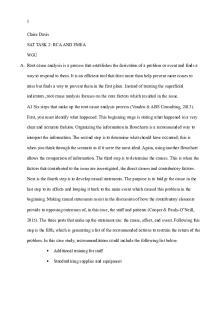C234 task 2 PDF

| Title | C234 task 2 |
|---|---|
| Course | Workforce Planning |
| Institution | Western Governors University |
| Pages | 3 |
| File Size | 50.9 KB |
| File Type | |
| Total Downloads | 97 |
| Total Views | 127 |
Summary
task 2...
Description
C234 – Task 2
A. Three causes of workplace conflict 1. Perception – the mayor believes that there are unfair policies in the handling of the overtime. The officers believe the mayor lacks an understanding of why overtime pay is needed. 2. Poor Communication – there was a press conference on the decision before the officers or the union were notified. This has caused the police officers to threaten action in the form of strikes if the mayor cannot communicate with them. 3. Loss of Income – the officers have been loyal and given their time and now they are facing a loss of income that they have gotten used to. The mayor is making harsh comments – such as the one about the “gravy train”. These perceptions are causing conflict between the mayor and the officers. B. Two potential short-term outcomes if the conflict continues 1. Officers will be losing money from overtime – so they might start calling in sick and taking extra time off to spend time with their families. These “sick outs” will leave the city in a state where there are less officers patrolling. 2. Officers may decide to start taking more time to do their work – slowdown in work means that there are less tickets being handed out and less money coming into the city. It also means that the officers are not being as effective as they were previously leading to more tension and conflict. C. Two possible long-term outcomes if the conflict continues. 1. Strikes – this could happen in wild card style or sit-down style. The officers have threatened this even if it means that they will need court approval. 2. Obstinance – the team could refrain from training new hires. By refusing to train a new hire they are delaying the rookie’s ability to be effective at their job. This means that it will take longer for the 25 new officers to reach their potential and can also lead to conflict between the old and new team members. D. Three possible actions for resolving conflict regarding overtime pay. 1. Negotiation – union and mayor sit down to reach an agreement on the conflicts and a way forward. This can be formal or informal but requires both parties to sit down and discuss potential resolutions.
2. Bonuses – in an effort to locate a win-win scenario the current officers will be missing over time pay they have come to rely on, the new hires need trained. A system where a current officer can train and work with a rookie and earn a bonus for the rookie’s completion of the 12-week training would be a win-win. 3. Arbitration – involve a 3rd party to mediate the conflict. This would be a last resort if the two parties are not able to come to a mutual agreement. Arbitration allows a non-involved party to help each side understand the issues and complaints and work through to a resolution. E. Positive Work Culture 1. Identify and discuss two components of a work culture that prevent negative conflict. i. Good hiring practices – weed out those who might cause conflict. Employee referrals of those who would fit with the team, preventing negligent hiring, and working toward effective hiring practices will help the team to ensure those they are hiring are the right fit. Good hiring practices will also lower turn over and increase retention. ii. Good policies that promote effective communication, open door policies, etc. 2. Create two new requirements that relate to a candidate’s ability to effectively manage workplace conflict. i. Active Listening – ability to listen to directives with complete attention. ii. Emotional Intelligence – ability to manage emotions and conflict. 3. Create 3 situational interview questions designed to illuminate a job candidate’s competency in managing a workplace conflict i.
A coworker is upset with their manager and is disparaging them to anyone who will listen. How do you handle this information?
ii.
Tell me about a time you disagreed with your supervisor – what happened and how did you resolve the disagreement?
iii.
What would you do if you found a co-worker lying to their boss about who completed their work? Who would you talk to?
F.
Identify and explain two metrics for evaluating employee relations improvements. 1. Grievances by area – determine what categories the grievance belongs in then how many of each happen – which areas need improvement. By dividing them into categories you can focus on the areas that need immediate improvements. 2. Overall Grievances – determine if the overall amount of filed grievances changes. Are less overall filed? Are less in any category filed? After focusing your efforts seeing a change in the amount filed will let you know if you are making the correct changes....
Similar Free PDFs

C234 task 2
- 3 Pages

C234 Task 1 Tim Fraim
- 5 Pages

Task 2 - Task 2
- 5 Pages

QHT1 Task 2 - Task 2
- 1 Pages

Task 2 - C226 Task 2
- 7 Pages

D082 Task 2 - Task 2
- 3 Pages

TDT1 Task 2 - Task 2
- 4 Pages

TET1 Task 2 - Task 2
- 4 Pages

DO81 - Task 2 - Task 2
- 5 Pages

C228 Task 2 - Task 2
- 6 Pages

D081 - Task 2 - Task 2
- 2 Pages

D093 Task 2 - task
- 6 Pages

Final CPC TASK 2 - task 2
- 44 Pages

Task 2
- 8 Pages
Popular Institutions
- Tinajero National High School - Annex
- Politeknik Caltex Riau
- Yokohama City University
- SGT University
- University of Al-Qadisiyah
- Divine Word College of Vigan
- Techniek College Rotterdam
- Universidade de Santiago
- Universiti Teknologi MARA Cawangan Johor Kampus Pasir Gudang
- Poltekkes Kemenkes Yogyakarta
- Baguio City National High School
- Colegio san marcos
- preparatoria uno
- Centro de Bachillerato Tecnológico Industrial y de Servicios No. 107
- Dalian Maritime University
- Quang Trung Secondary School
- Colegio Tecnológico en Informática
- Corporación Regional de Educación Superior
- Grupo CEDVA
- Dar Al Uloom University
- Centro de Estudios Preuniversitarios de la Universidad Nacional de Ingeniería
- 上智大学
- Aakash International School, Nuna Majara
- San Felipe Neri Catholic School
- Kang Chiao International School - New Taipei City
- Misamis Occidental National High School
- Institución Educativa Escuela Normal Juan Ladrilleros
- Kolehiyo ng Pantukan
- Batanes State College
- Instituto Continental
- Sekolah Menengah Kejuruan Kesehatan Kaltara (Tarakan)
- Colegio de La Inmaculada Concepcion - Cebu

